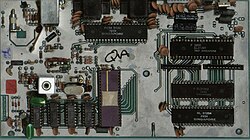Fairchild Channel F
The Fairchild Channel F (also known as Channel F) is a home video game console. The "F" in the name stands for "Fun".[1] It was designed by Jerry Lawson and released in November 1976 by Fairchild Camera and Instrument in the United States for a price of 169.95 $.[2] It is the first console that uses ROM cartridges and a microprocessor. By 1977, 250,000 Fairchild Channel F consoles were sold.[3] The production ended in 1983.[4]
Licensed versions
Many licensed versions were released in Europe. For example, the Luxor Video Entertainment System (Sweden), Adman Grandstand (United Kingdom), Saba Videoplay, Nordmende Teleplay, ITT Tele-Match Processor (Germany) and Dumont/Barco Videoplay (Italy and Belgium).[2]
Games
26 cartridges were officially released for the Fairchild Channel F. Some cartridges have several games included. Each cartridge was sold for 19.95 $.[5] On November 5, 2009, a homebrew game, a version of Pac-Man, was released.[6]
List of games
- Integrated with console: Hockey, Tennis
- Videocart-1: Tic-Tac-Toe, Shooting Gallery, Doodle, Quadra-Doodle
- Videocart-2: Desert Fox, Shooting Gallery
- Videocart-3: Video Blackjack
- Videocart-4: Spitfire
- Videocart-5: Space War
- Videocart-6: Math Quiz (Addition & Subtraction)
- Videocart-7: Math Quiz (Multiplication & Division)
- Videocart-8: Mind Reader, Nim (also referred to as Magic Numbers)
- Videocart-9: Drag Strip
- Videocart-10: Maze, Cat and Mouse
- Videocart-11: Backgammon, Acey-Deucey
- Videocart-12: Baseball
- Videocart 13: Robot War/Torpedo Alley
- Videocart-14: Sonar Search
- Videocart-15: Memory Match
- Videocart 16: Dodge-It
- Videocart-17: Pinball Challenge
- Videocart-18: Hangman
- Videocart-19: Checkers
- Videocart-20: Video Whizball
- Videocart-21: Bowling
- Videocart-22: Slot Machine
- Videocart-23: Galactic Space Wars
- Videocart-24: Pro-Football
- Videocart-25: Casino Poker
- Videocart-26: Alien Invasion
- Videocart-27: Pac-Man (homebrew)
Technical specifications
- RAM: 64 byte[2]
- VRAM: 2 kilobyte
- CPU: Fairchild F8 operating at 1.79 MHz[2]
- Display resolution: 128 × 64 pixels[2]
- Colors: eight colors
- Audio: 500 Hz, 1 kHz, and 1.5 kHz tones. The tones can be modulated to produce more tones.[2] The sound is played through internal speakers build in the console, not through the television.[2]
- Input: two custom game controllers, hardwired to the console
Successor
In 1979, the successor named Fairchild Channel F System II was released.[7]
Fairchild Channel F Media
The palette of the Channel F
References
- ↑ Edwards, Benj (2015-01-22). "The Untold Story Of The Invention Of The Game Cartridge". Fast Company. Retrieved 2020-06-04.
- ↑ 2.0 2.1 2.2 2.3 2.4 2.5 2.6 "Adman Grandstand (Fairchild Channel-F) Video Entertainment Computer - Game Console - Computing History". www.computinghistory.org.uk. Retrieved 2020-06-04.
- ↑ Jones, Gareth R.; Hill, Charles W. L. (2007). Strategic management: an integrated approach (7th ed.). Boston: Houghton Mifflin. p. C-123. ISBN 0-618-73166-0.
- ↑ Wolf, Mark J. P. (2018-11-21). The Routledge Companion to Media Technology and Obsolescence. Routledge. ISBN 978-1-315-44266-2.
- ↑ 1976 commercial trailer: https://www.youtube.com/watch?v=jXvpsmanhsk
- ↑ "Homebrew:Pac-Man - veswiki". channelf.se. Retrieved 2020-06-04.
- ↑ "Fairchild Channel F / Channel F System II (1976 – 1984)". Museum of Obsolete Media. 2018-01-24. Retrieved 2020-06-04.
Other websites
| Wikimedia Commons has media related to Lua error in Module:Commons_link at line 62: attempt to index field 'wikibase' (a nil value).. |









